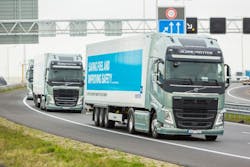Not only are key European automotive heavyweights preparing to roll out autonomous cars just three short years from now, truck makers across the pond are preparing to launch semi-autonomous truck convoys commonly called “truck platooning” within the region some six years from today – if such a timeline can withstand regulatory and societal scrutiny, that is.
Erik Jonnaert, secretary general of the European Automobile Manufacturers’ Association (ACEA), presented the group’s EU Roadmap for Truck Platooning to policy makers attending the European Parliament this week – a roadmap he said “provides an overview of the steps that are necessary” to implement “multi-brand” truck platooning across the continent six years from now.
“By 2023, it should be possible to drive across Europe on motorways with multi-brand platoons, without needing any specific exemptions for crossing national borders – a prerequisite for international transport,” Jonnaert said in a statement.
It’s probably worth a moment of pause here to revisit just what “truck platooning” means and what benefits it is supposed to deliver. According to ACEA’s policy paper:
- Truck platooning is the linking of two or more trucks in convoy, using “connectivity technology” and “driver support systems” to keep them close together safely in order to achieve fuel efficiency gains.
- The truck at the head of the platoon acts as the leader, with the vehicles behind reacting and adapting to changes in its movement, with little to no action from drivers.
- Platooning allows trucks to drive closer together, thereby significantly reducing their air-drag friction – which in turn can reduce fuel consumption and carbon dioxide (CO2) emissions by up to 10%.
- Given that braking is automatic and immediate, truck platooning helps to improve safety too. Platoons of trucks also use roads more effectively, thus delivering goods faster and reducing traffic jams.
However, Jonnaert stressed that fully-autonomous trucks – ones that would enable the driver of vehicle within a platoon to “take a rest” in his words – will only come later on.
And while European truck makers are already exploring the business case for truck platooning with the logistics sector, Jonnaert emphasized that “certain conditions” that need to be met before 2023 to make it a viable reality “are beyond the control” of Europe’s trucking industry – conditions that will affect efforts to get truck platooning efforts off the ground in the U.S. as well.He explained that, for starters, Europe will need to create a “supportive regulatory framework” before truck platooning can become a “common sight” – a “framework” that includes the development of new rules, changes to existing legislation, and the harmonization of both international and European Union (EU) regulations.
At the same time, Jonnaert stressed that “it will be imperative” to get political support for promoting the wide-spread introduction of platooning and may require the use of various incentives, such as toll and tax reductions, CO2 reduction “bonuses,” and even “flexibility” in driving time – which translates into hours of service (HOS) rule changes here in the states – to “stimulate the market uptake” of truck platooning.
“That’s why we will also need to strengthen cooperation between all players involved, including operators of road infrastructure, transport companies, regulators and insurance companies, but policy makers in particular,” Jonnaert pointed out.
“The technology for platooning with trucks of the same brand is already available today,” he added. “But clearly customers will need to be able to platoon with trucks of different brands, so our next objective is to introduce multi-brand platooning.”
That – along with all the other requirements for making truck platooning a fiscally worthwhile effort – will take some doing to achieve.
But the Europeans think it can be done, if everyone works together, in six years. Can a similar timeline be developed for the U.S.? Stay tuned.

